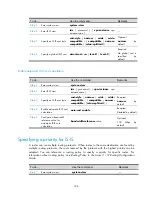
171
Figure 54
IS-IS topology 2
The IS-IS backbone does not need to be a specific area.
Both the IS-IS Level-1 and Level-2 routers use the SPF algorithm to generate the SPT.
Route leaking
An IS-IS routing domain is comprised of only one Level-2 area and multiple Level-1 areas. A Level-
1 area consists of a group of Level-1 routers, and is connected with a Level-2 area rather than
other Level-1 areas.
The routing information of a Level-1 area is sent to the Level-2 area through the Level-1-2 router.
Therefore, the Level-2 router knows the routing information of the entire IS-IS routing domain, but
does not share the information of other Level-1 areas and the Level-2 area with the Level-1 area
by default.
Because a Level-1 router simply sends packets destined for other areas to the nearest Level-1-2
router, the best paths may not be selected. To resolve this problem, route leaking was introduced.
A Level-2 router can advertise Level-2 routing information to a specified Level-1 area. By having
the routing information of other areas, a Level-1 router in the area can make a better routing
decision for a packet to another area.
IS-IS network types
Network type
IS-IS supports the following network types:
•
Broadcast network, such as Ethernet and Token-Ring
•
Point-to-point network, such as PPP and HDLC
















































